
In a number of surveys Albarracin has been voted either the top or one of the most beautiful villages or small towns in Spain, and it is just over three hours drive for us, the other side of Valencia.
Although we have photos here is a video of the village which beats our amateur pictures
In 2001 we visited Albarracin for the first time. Below is a write up of that trip where we stayed in Albarracin and then travelled to Siquenza and Huerte.
DAY 1
Left Javea at 10.45 am on Motorway to Valencia, leaving the ring road at Valencia on the CV35 for Lliria and Ademux
Benisano has its own curious castle(privately owned) and 3 old gateways still standing.
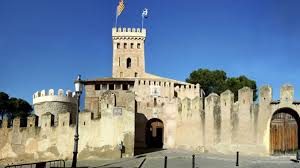
Benisano Castle
We then went on to Lliria

Lliria
which is the music city of Valencia and here was formed the first civic band of Spain. The Convent of San Miguel which overlooks the town has a courtyard with a pretty painted chapel.
From Lliria to Casinos – long stretches of road with concrete irrigation channels. The country is planted with olives, artichokes, almonds and vines. Casinos is renowned for its peladillas – sugared almonds – a tasty souvenir sold in several shops
The first possible detour is to a lush green valley and the little village of Chulilla surrounded by cliffs. To get there take the Requena turning 9 km after Casinos, through Vanadoig a semi-abandoned village with a farm school. Leaving the fields behind you enter an area of heavily wooded hills. Turn right at the next junction into Chulilla
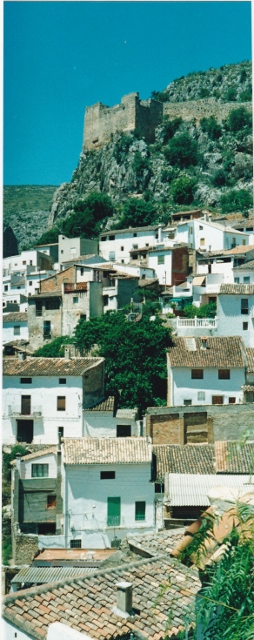
Chulilla
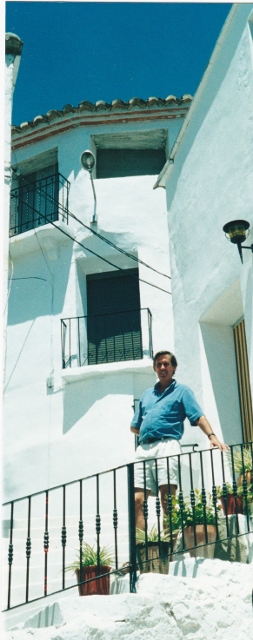
Tony in Chulilla
If you go down to the river from here you will find the spa of Fuencaliente where there is a hotel-restaurant. Carry on through the village and stop after the last houses to look left at the view of dramatic, red cliffs pock-marked with caves. This lane now brings you back to the C35 at Losa de Obispo
The road to Ademuz has run more or less straight since Lliria but now it winds into attractive hills of bare rocks, pine and carob trees. Round a curve you suddenly come across Loriguilla reservoir, which has a waterfall at one end and the ghost village of Domeno at the other. The inhabitants of Domeno were forcibly rehoused elsewhere to make way for the reservoir: but some of the houses have been rehabilitated by homeless people. As the water-level rises and falls it covers and uncovers the old bridge.
Chelva is 6 km further on. A 4 km detour out of town is Pena Cortada: a local beauty spot near the ruins of the Roman aqueduct. To reach it, turn right off the main road in the town centre(as sign-posted) Turn right again onto the track (rough but passable) by the side of a white-washed bullring, which first heads for a Moorish tower. From here the signs are not so clear. Fork left after the tower and right at the next junction. After a while, the track enters a narrow river valley. The ruined arches of the aqueduct appear on the left. Pena Cortada is 1 km further on but the track becomes badly eroded and it would be better to leave your car by the aqueduct and walk.
Another excursion from Chelva takes you up to Pico del Remedio a 1,000m viewpoint.
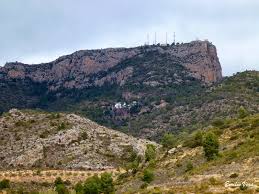
Pico de Remedio
To get there, keep to the surfaced road by the bullring. Continuing towards Ademuz on the C234 there is another side excursion after 5 km. A left turning takes you along a scenic route to Benageber dam (18km) and Serratilla nature reserve.
For a picnic the Nacimiento del Rio Tuejar is a short way off the road on the right by the river. Centro Altur near here is the departure point for treks around the rugged forests of the Alto Turia region. It also has a restaurant.
The road now twist to the Montalbana Pass through hills of pine trees, and down to Titaguas an excursion centre for hikers.
From Titaguas it is worth making a short detour to see Alpuente, a pretty village which was once the capital of a Moorish Kingdom and briefly in the 14th century the seat of the Valencian Parliament. The quaint town hall sits in cramped quarters over an ancient gateway – outside the village is a medieval aqueduct – photos below
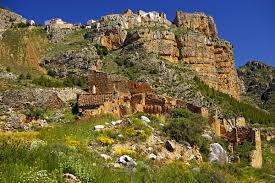
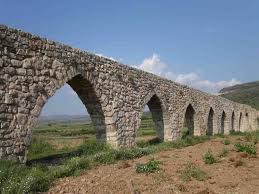
Between Titaguas and Aras de Alpuente the road passes through vineyards and pine woods of the Dehesa del Rebollo. Aras de Alpuente has a prominent tower. Not many places to eat but Los Tornajos is clean and simple. It specialises in morteruelo a rich game dish, trout with almonds, homemade sausages and roast leg of lamb,
The next part of the route is the most picturesque. The road traverses a large pine forest and comes down into a deep gorge with the River Turia at the bottom, which you cross by a high bridge.
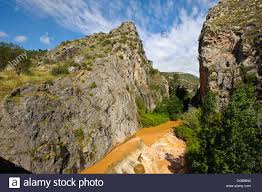
Sta Cruz de Moya gorge
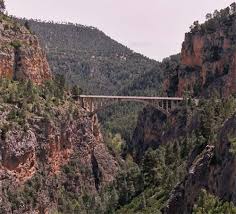
Sta Cruz de Moya bridge
Stopped for lunch at Bar Avenida in Sta Cruz de Moya – Basic Café but good food at super prices.
After a series of hairpin bends the road drops deeper down into the gorge and crosses back into the province of Valencia, more precisely into Rincon de Ademuz. You pass through two villages before reaching Ademuz – Casa Bajas by the river which has some adobe houses and Casas Altas.
Ademuz is a decaying mountain town that has seen better days.
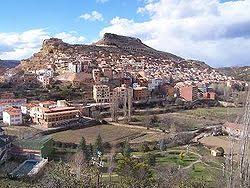
Many of the buildings are timber framed and have wooden balconies. The only place to stop is Casa Domingo, an enormous rectangular cream building on the way out of town which serves as a bar-cum-restaurant-cum-gift shop.
Pass through Libros a pretty village on the river. You are now on the N330 a good road which takes you swiftly through Villel with its ruined castle towards Teruel following the River Turia across a landscape of red earth. At the end of this the modern outskirts of Teruel appear ahead quickly followed by the whole compact silhouette of this rose-coloured city full of romantic architecture. We visited this town in another trip.
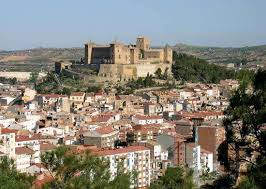
Teruel
From Teruel take the N234 north and after 5 km turn off onto the A1512 for Albarracin (29km) The road runs dead straight for 10KM across a very dry upland plain but then gradually curves into the hills. See the wheat fields we passed.
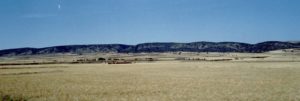
The first town you come across is Gea de Albarracin, which has stone buildings, wood frames houses and old pantiles roofs: a taste of what is round the next few bends.
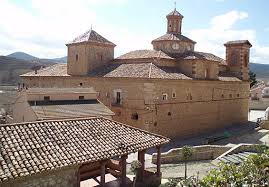
Gea de Albarracin,
From here, the road follows a pretty valley. Soon you round a corner and get a glimpse of a tower and the upper walls of the historic town of Albarracin its narrow streets of tall, reddish houses perfectly preserved over the centuries.
We stayed at the hotel Casa de Santiago. We paid 12,000 Ptas (€70) plus IVA Room only (we had a large double suite with spectacular views) See brochures on Hotel and Albarracin. Thoroughly recommend Hotel and Town – wish we had stayed for 2 days
DAY 2
Stayed the night and next morning we started on day two of our trip where we covered 217 km
Leave Albarracin on the TE903 through the tunnel and carry on up to the gorge alongside the river. After 2 km there is a restored but inconspicuous Roman bridge on the left. We saw some amazing fields covered with poppies
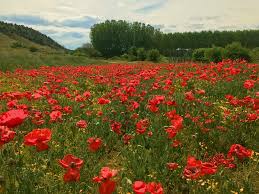
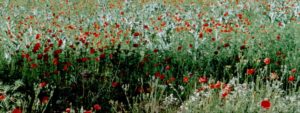
The road climbs up into sparsely wooded hills and curves down to a left turning to Frias de Albarracin (17 km) This road is not marked to Frias but to Moscardon/Royuela Not a clear road sign but is the TE 911. Cross the River Guadalaviar. At the fork before the small bridge turn right on to an unclassified road for Cuenca via Frias de Albarracin.
The countryside opens up into a wide valley and the road climbs into wild hills, which, with their reddish rodeno rocks and stands of savin (a kind of juniper – the leaves are aromatic when rubbed) are typical of the scenery of the Montes Universales. Broad fields of red earth surround Colamarde, a hamlet of old stone houses.
Just outside the village the road forks – take the one uphill to the right for Frias de Albarracin.
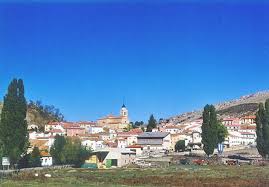
Frias de Albarracin
With its cobbled streets and little white houses, the village sits at the base of a prominent conical hill. Turn right at the bottom of the village for Cuenca and the Nacimiento del Rio Tajo (11.2km) You are soon up in the hills again.
The trees start thinning out and give way to gravely slopes covered with dense, flat clumps of juniper. This area is walking country. You cant miss the Nacimeiento del Rio Tajo – the source of the river Tagus, that mighty river which, as the Tajo drains into the Atlantic at Lisbon 1,008 km from here (the longest river in the Iberian Peninsular) because it is marked by an enormous metal statue.
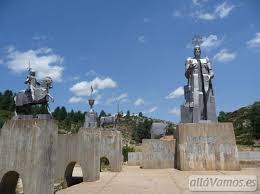
The statues
There is however no water to be seen. The actual source is a fountain, the Fuente de Garcia 150 metres along a track behind the monument but even this is unspectacular as the water from it disappears into the ground.
Take the road signposted to Tracete and Cuenca. This is a spectacular drive – partly brand new road , then a poor road climbing down with wonderful views. Reaching the bottom turn right to Tracete not left to Cuenca this is the CM2106.
On reaching Tracete you will find a petrol station which is the only one between Albarracin and here. Also many hostels if you wish to stay in this area which is famous for walking. Stay on the CM2106 – at junction take the right turn to Peralejos de las Trunchas and Molina (left goes to Beteta).
The CM2106 descends through mountain passes, heavily wooded with enormous rock formations and lots of eagles You are now in the province of Guadalahara and the road is poor. Passing by Peralejos you are in rolling countryside and then climbing up and down mountain passes towards Terzaga on the left – the road now improves and changes to the CM210 going through rolling countryside until you come round a bend and see Molina de Aragon in front of you. You can see the castle on the hill with the town underneath.
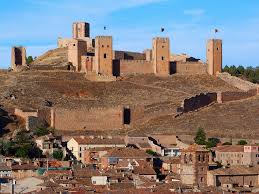
Molina de Aragon
Here you turn onto the N211 to Alcolea del Pinar which is a very fast road then briefly onto the N11 but then immediately onto the CM110 to Siquenza
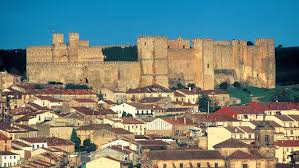
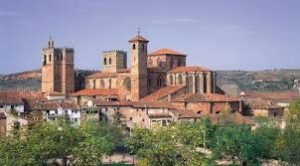
Siquenza Cathedral
We stayed at the Parador de Siquenza being Ptas 34,280 (€209) total for Room and Dinner (not including breakfast) Very disappointed in service and attitude at the Parador compared to other hotels on this trip.
DAY 3
So we started day 3 where we did 172 km
Straight down from Siquenza on road to Guadalajar, joining the N11 the fast road to Madrid. At Guadalajara watch for the N320 to Cuenca. All these roads are fast roads on the level plains, where you can make very good time. After approx 15 minutes on the N320 watch out for the CM2006 to Hueva on the right. This is a slower road and you pass Hueva and go onto Pastrana.
Pastrana is an old town worth a visit (the day we visited Wednesday, was Market Day) Full of character – Lots of lovely old buildings
Leaving Pastrana the road is now CM200 and signposted to Almonacid de Zorita. You are again in rolling countryside. Passing Almonacid (possibly worth a visit) you pass through Albalate de Zorita and then passed the sign to the Lake of Buzeda.
Watch for left turn marked Saceda Trasierra. You climb a hill and at the top you have incredible views as far as the eye can see of arable lands.
Passing down to Vallisca you turn right at the T Junction and go through the village.
Here we made a mistake. We took a left turn signposted Huete. It was 10.5 Km of very bad road. Better to take road straight on to N400 and then left and soon after left again onto CH310 to Huete.
Possibly coming in on the ‘wrong’ side we got lost in Huete – a larger town than we expected. Found the hostal with some local assistance – the Casa Palacio (it didn’t have a website in 2001) Certainly worth a visit – away from it all and very peaceful It was Ptas 12,000 (€72) for large room with ensuite and breakfast.
Day 4
So the return trip to Jesus Pobre where we travelled 435 kms
Leave Huerte on the CM310 to Carascosa. Straight across the N400 and on to Saelices. Then across the N111 still on CM310. After 10 mins turn left at a roundabout onto CM3011. Pass through Pueblo de Almenara, Tresjuncos and Osa de la Vega. Then turn right onto N420 and 2 Km to Belmonte. All these are very fast minor roads through agricultural land – wheat etc.
Initially disappointed in Belmonte, then found a lovely little hotel Palacio Buenvista Hospederia, see brochure, plus view of the late Gothic castle used in one of the sets of El Cid. turned out to be a pretty unspoilt village has streets of white houses. The hills around were once forested and they provide the backdrop for Don Quixotes squirmish with the Knight of the wood – one of the few battles he actually won by luck.
Take CM5102 from Belmonte to El Pedernosa then fast route back to Javea
Left on N301 to La Roda and Albacete/ Then N430 to Almansa, Villera, Elda and Alicante/ Then A7/E15 home.
Brochures and maps of Albarracin available in the folder
A great trip.